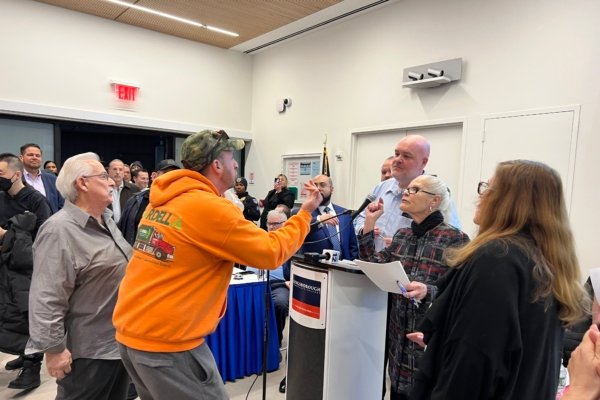Brooklyn’s 15th Community Board held a meeting on the evening of March 25 to discuss the establishment of a long-term homeless shelter that can accommodate 175 families at 2134 Coyle Street in Sheepshead Bay. The meeting attracted thousands of residents, with over 2,000 seats filled, primarily by Chinese residents, creating a heated atmosphere. Hundreds of residents who couldn’t enter the venue gathered outside, expressing their dissatisfaction with the proposed homeless shelter.
Officials from the New York City Department of Social Services (DSS) stated that the proposal for the new facility was selected through a public Request for Proposals (RFP) process. According to the process, property owners collaborated with the service provider Westhab to submit a proposal, which was then reviewed and approved by DSS. DSS emphasized that the plan was announced to the community in July 2023, highlighting that the facility aims to provide temporary housing and support services for families with children.
Regarding the change from the initially planned affordable housing project to a homeless shelter, Jim Kauffman, the CEO of Westhab, the operator of the shelter, explained that Westhab was not involved in the original transaction. He clarified that the project was awarded through a competitive bidding process and complied with all regulations.
Kauffman further explained that the shelter was purchased and built through a collaboration between developers and non-profit organizations, with assistance from the New York City Department of Homeless Services (DHS) in financing the loan. After 30 years, the building will be owned by a non-profit organization. The buildings have permanent restrictions, meaning they must continue to function as shelters or affordable housing units even if the homeless issue decreases in the future.
Residents raised concerns about the lack of notification to the community and the inadequate consideration of the community’s infrastructure capacity in selecting the site for the shelter. They mentioned that there are already eight child service facilities in the vicinity, believing that the new shelter would add pressure to the community resources. Some residents also expressed worries about the increasing crime rates in the area and feared that the shelter’s establishment would further impact community safety.
A resident living behind the homeless shelter at 2134 Coyle Street, Simona, expressed her frustration, noting that she invested her savings as a down payment and has been paying off the mortgage and property taxes. She chose the area for its quiet and private residential environment, only to have the shelter construction plan changed without adequate information provided to the residents. She said, “These deceptive actions from the companies caught us off guard, threatening to sue us for trying to defend our rights.”
Furthermore, residents questioned the familial relationship between Valerie Smith, Westhab’s Vice President, and Joslyn Carter, New York City’s Homeless Services Director, suspecting collusion between them. According to the City Comptroller’s office data, since Smith joined Westhab in 2017, the organization has received contract and renewal amounts exceeding $2.5 billion. Kauffman emphasized that the relevant circumstances had been reviewed by the New York City investigation department, and no misconduct was found.
The atmosphere at the meeting was intense, with continuous opposition from the community residents. One resident questioned, “This community does not support this project. Why build a homeless shelter in a community that doesn’t want it?”
Kauffman replied that they operate over 20 projects and have participated in similar meetings for many years. He stated that in his 25-year career, he had never encountered a community welcoming a shelter. He stressed that this issue fundamentally revolves around “fair share,” with every community needing to participate, even though it is an unfortunate but necessary reality.
Residents also queried the need for 24-hour security if the shelters are considered “good neighbors,” questioning who would ensure the community’s safety. Another resident inquired, “If homeless individuals are near us during the day, would there be safety concerns?” Residents expressed shock at learning about the new project only two weeks prior.
Many residents criticized the establishment of the shelter as unfair to hardworking taxpayers and demanded that the Community Board better fulfill its responsibilities in such projects, stating, “Their duty is to serve us, the tax-paying residents.”
One resident asked, “When you purchased the property, it was originally intended for affordable housing, but now it’s being converted into a homeless shelter. Considering the current urgent need for affordable housing, is this decision reasonable?”

